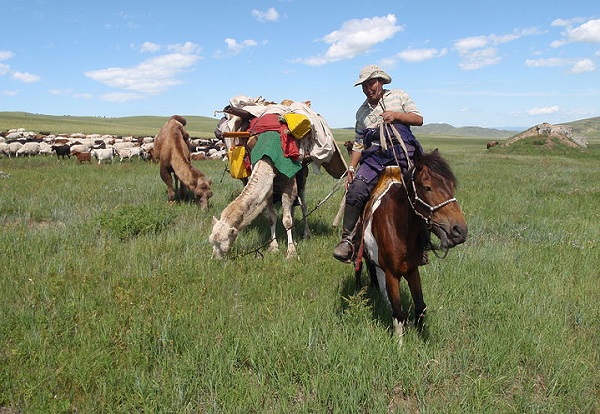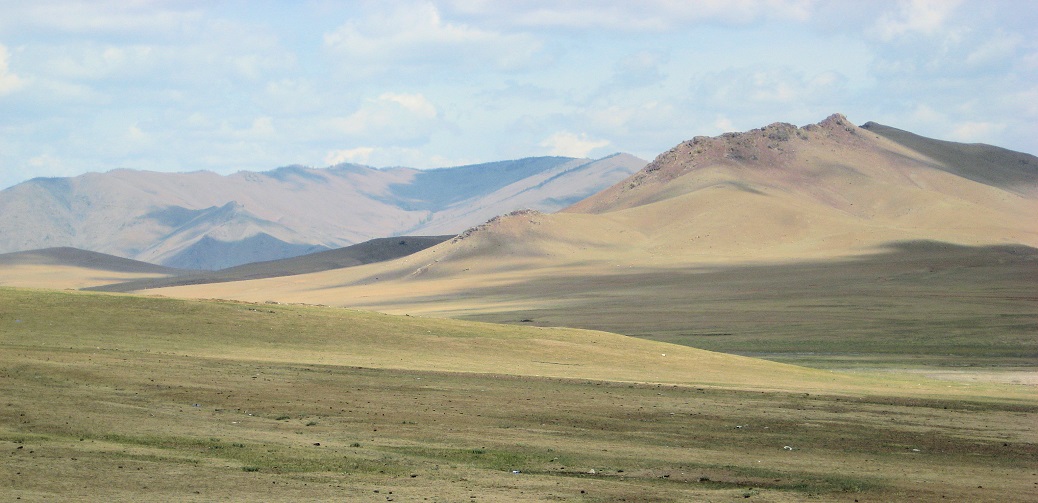The biggest single driver of events in European and Asian history has been the migration of peoples across the open grasslands of northern Eurasia. In the millennia between the domestication of the horse and the age of gunpowder, nomads ranged across this Great Eurasian Steppe which spanned the two continents, bringing trade and war by turns. The southern reaches were crisscrossed by the trails of the Silk Road, whose merchants were sometimes aided and sometimes raided by nomadic tribesmen, depending on the time and place.

The Great Eurasian Steppe stretches from the plains of eastern Hungary to the Pacific coast of Asia, sandwiched between forests to the north and mountains and deserts to the south. The vast stretches devoid of trees and other large vegetation allowed the unhindered migration of people and their flocks over some 5,000 miles.
This open space also gives rise to incredible extremes of weather. Howling winds whip up which are unblocked by trees, and temperatures can swing from 80 degrees Farenheit during the day to below freezing at night.
The harshness of life in this high, dry landscape meant that humans of the past could only survive by relying on creatures even hardier than they. The tough local breeds of goats, sheep, camels, and cows provided food and raw materials for the nomads of the steppe.

The most essential animal, however, was the Mongolian horse – a small, stocky breed that resembles a pony, able to travel long distances in the most trying conditions, while rooting out grasses to eat from under the heavy snowdrifts of brutal winters. This unique breed allowed tribes to guide their flocks over large distances in their continuous search for new grazing lands, and occasionally to form massive armies that were able to attack distant settled lands.
The Engine of History
The constant movement of peoples on the Great Eurasian Steppe inevitably led to conflict. The migration and conquest of a nomadic tribe in one area would create a self-replicating pattern. Displaced populations would in turn displace others, causing a chain reaction that could ripple across thousands of miles.
The effects of this could be incredibly destructive, even bringing down empires. The Visigoths’ sack of Rome in 410 happened as a direct consequence of their expulsion by the Huns from the Black Sea region. The Huns, who themselves later besieged Rome, may have been forced to migrate westward as a result of drought.
The ancient Greeks, whose trade colonies on the far side of the Black Sea put them in direct contact with steppe nomads, were very familiar with this pattern of history. They were the first to write ethnographies of the various groups living on the grasslands, and noted how one tribe would displace another.

This ethnographic tradition was passed from the ancient Greeks to their descendants, the Byzantines, who used it to great advantage. The Byzantine Empire, which survived the barbarian invasions that brought down the Western Roman Empire, was constantly beset by new adversaries. Realizing that totally destroying any one of these would create a vacuum into which more dangerous enemies could establish themselves, successions of emperors devised a long-term strategy to deal with the perennial threat. Ambassadors would be sent to form alliances with distant tribes, who would be induced by cash payments to join the Byzantines in an attack on one of their nearby enemies. The defeated enemy would in turn be offered a treaty in which they would protect the empire against outlying threats (this is described in very entertaining detail in Edward Luttwak’s Grand Strategy of the Byzantine Empire).
The Chinese followed a similar strategy. They would frequently pay off tribes on their norther frontier to defend against more dangerous potential enemies farther afield, and bribe distant tribes to attack nearby enemies as well.
Empires on the Great Eurasian Steppe
Nomadic pastoralists were by nature fractious, enjoying the freedom of the open steppe. Occasionally, however, they would consolidate into larger political structures. The mobility afforded to horsemen by the vast grasslands allowed rulers to communicate across distances not possible before the industrial age.
The Huns were the earliest known example of nomadic empires. Their state was essentially a confederation of many different steppe tribes of various ethnicities and languages—the number of ethnic Huns was thought to have been relatively small. Turks in East Asia managed a similar feat in the 6th century, ruling a khaganate that stretched from the northern Caucasus to the northern reaches of China. Turkish hegemony lasted the better part of two centuries, despite a split in the empire following a civil war.
The power of these nomadic confederations reached its height with the Mongols under Genghis Khan. Within a few decades of uniting the Mongol and Turkic tribes of eastern Asia, the great conqueror had subjugated China, Persia, Russia, and all the steppe land lying in between. Despite savage wars of conquest that depopulated vast tracts of land all over Asia, the Mongol era brought about an era of relative peace and stability, with land routes between China and the West opened up for trade and cultural contact. It was during this period that Marco Polo set out on his great expedition across the Asian continent, his passage safeguarded by Mongol princes.
Steppe nomads contributed to civilization in many other ways as well. Because they ranged over such enormous distances, they spread their artwork, livestock breeding techniques, and even botanical cultivation all across Europe and Asia. Indeed, the domestication of the horse and falconry are thought to have begun in Kazakhstan and Mongolia, respectively.
Apples originated in the Tian Shan mountains of Central Asia, perhaps first cultivated by nomadic pastoralists who returned with their flocks year after year in the summer months to the cooler highland pastures. And all throughout history, nomads facilitated the movement of people, animals, and goods along the great network of routes known as the Silk Road.
Closing of the Great Eurasian Steppe
The age of the open steppe began its end in the 15th century. By this time, the lords of Moscow had gained enough power and prestige to unite the other Russian princes against their nomadic Tatar overlords, descendants of Genghis’ empire. From then on there was a steady eastward march of sedentary Russian populations, using the firepower and organization of an early modern state to subdue the nomads in their path.
At the other end of the continent, the Manchus of China’s northern borderlands soon took over that empire and extended its reach to the Mongolian heartland. These two conquering empires met near where the border between China and Russia lies today, compartmentalizing the once wild and open steppe into the grassland preserves of today’s nation states.
Interested by this? Read more:
The Empire of the Steppes: A History of Central Asia. A survey of the various empires that formed on the Great Eurasian Steppe.
Genghis Khan and the Making of the Modern World. A flawed but entertaining history of the Mongol Empire and the influence it had on world history.
The Grand Strategy of the Byzantine Empire. How Byzantium outlasted the Western Roman Empire by a thousand years by using one enemy against another. Describes the dynamic of displacement across the steppe, and goes into particularly good detail on the Huns.




